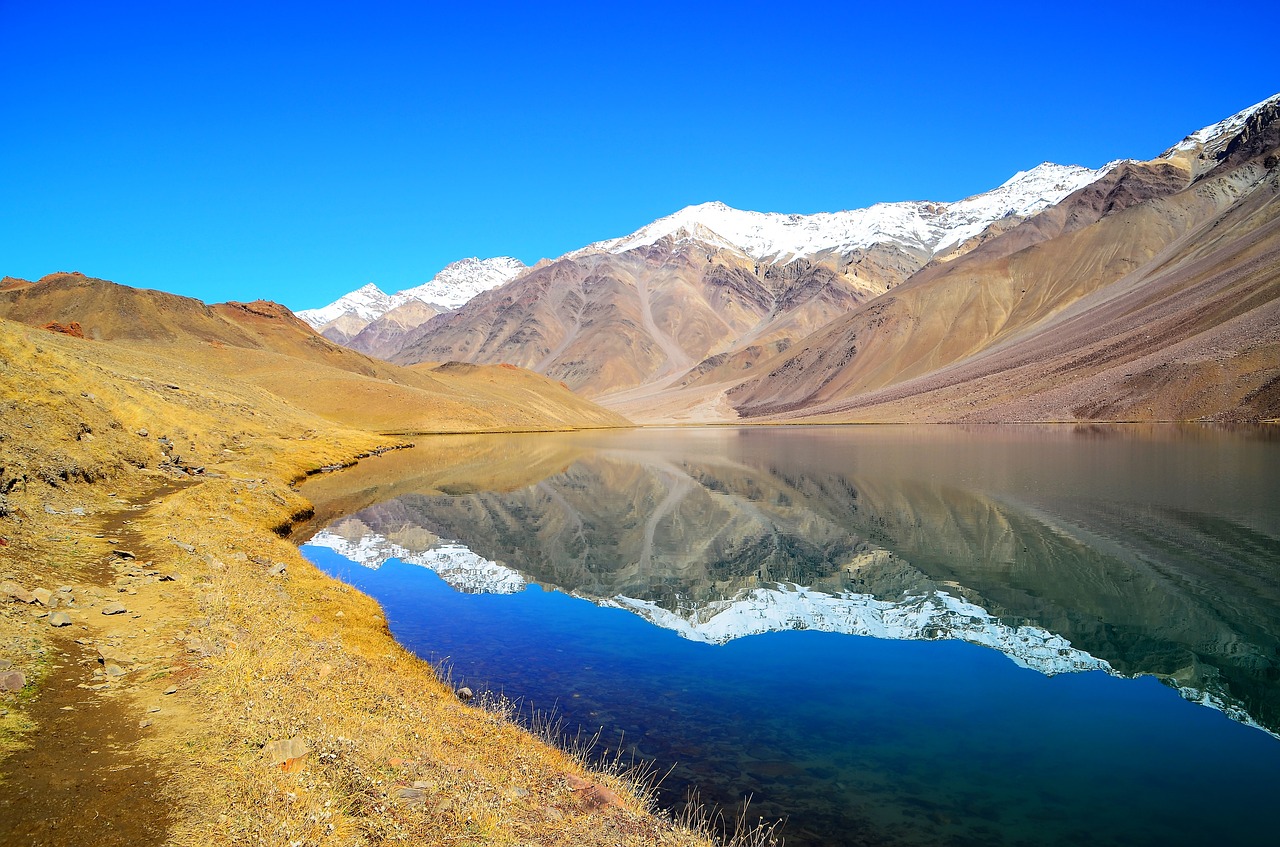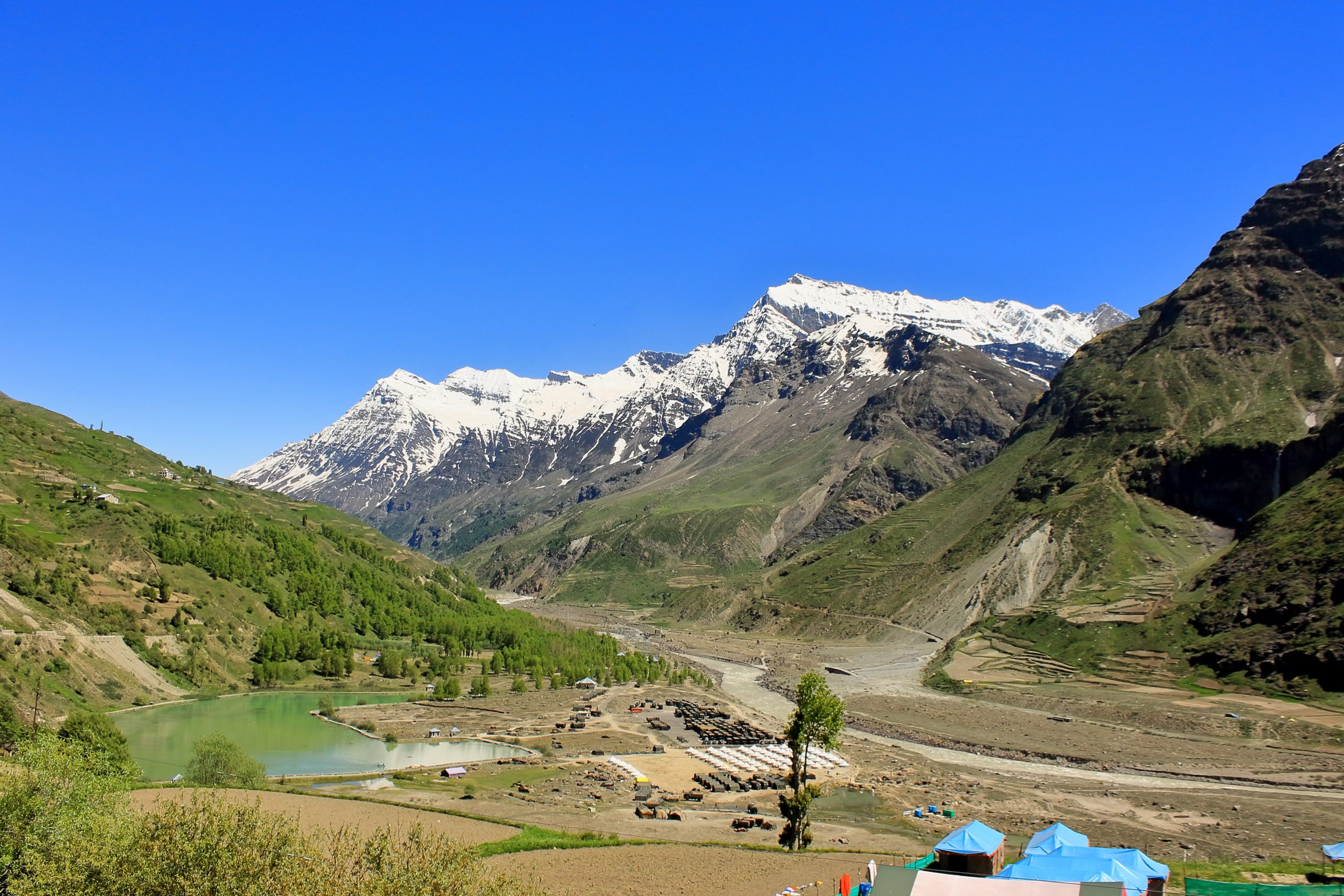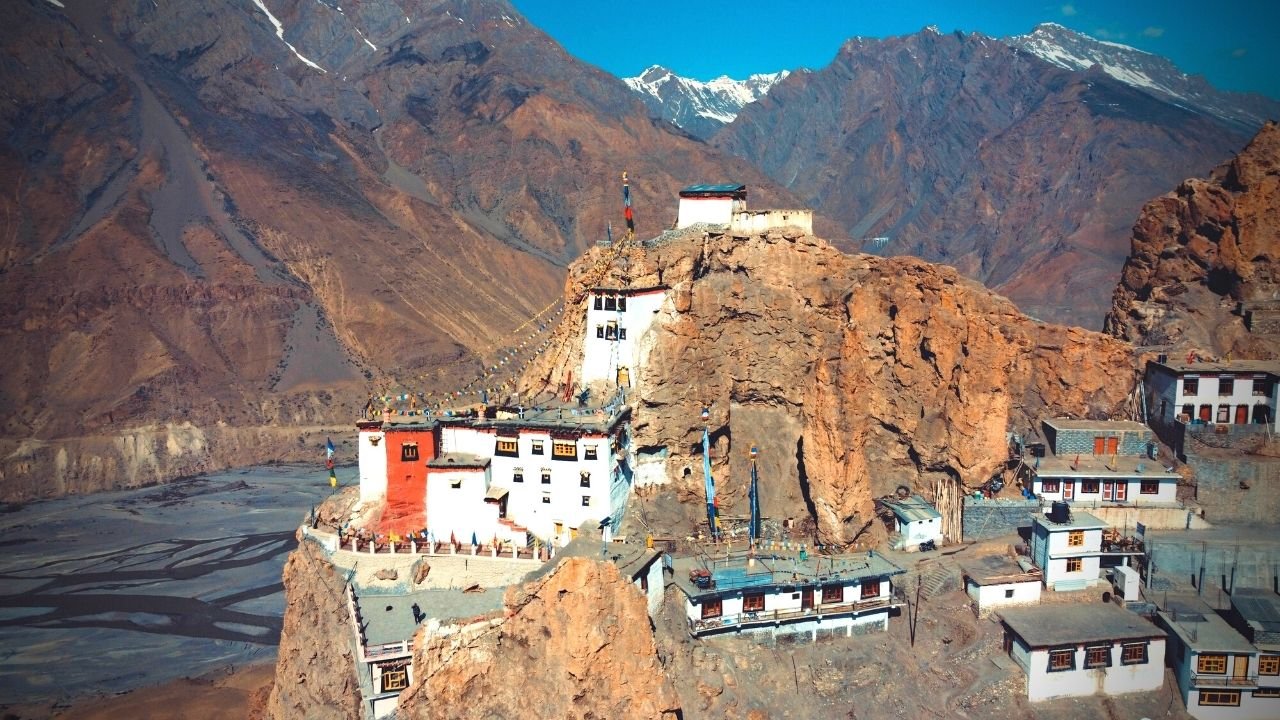Spiti Valley, often referred to as "Little Tibet," stands as one of India's most spectacular high-altitude desert destinations in Himachal Pradesh. This cold desert mountain valley offers breathtaking landscapes, ancient monasteries, and unique cultural experiences that make it a paradise for adventure seekers and spiritual travelers alike. The places to visit in Spiti Valley combine natural beauty with rich Buddhist heritage, creating an unforgettable journey through some of the world's most pristine wilderness areas.
Table of Contents
Overview of Spiti Valley
Spiti Valley represents one of India's most remote and beautiful mountain destinations, offering visitors an authentic Himalayan experience.
Located at an average altitude of 4,270 meters above sea level, Spiti Valley serves as a high-altitude cold desert nestled between Tibet and India. The valley's name translates to "The Middle Land," perfectly describing its position between Tibet and the Indian subcontinent. The must visit places in spiti valley showcase a unique blend of stark lunar landscapes, emerald rivers, ancient Buddhist culture, and some of the highest motorable villages in the world. The region remains cut off from the outside world for nearly six months due to heavy snowfall, making it even more special for those who venture here during the accessible months.
| Best Visiting Months | Key Attractions | Altitude Range | Accessibility |
|---|---|---|---|
| May to October | Monasteries, Lakes, Villages | 3,000m - 4,500m | Road accessible |
| June to September | Peak season | 4,000m - 4,500m | All routes open |
| May & October | Shoulder season | 3,500m - 4,200m | Limited accessibility |
| November to April | Closed season | Snow-covered | Mostly inaccessible |
Top 10 Places to Visit in Spiti Valley
These carefully selected destinations represent the most spectacular and culturally significant places to visit in Spiti Valley, each offering unique experiences and breathtaking beauty.
1. Key Monastery (Ki Gompa)

The largest and most famous monastery in Spiti Valley, Key Monastery stands majestically at 4,166 meters.
Founded over 1,000 years ago, Key Monastery serves as the biggest monastic complex in Spiti Valley and houses over 300 monks. This ancient Gelugpa monastery showcases traditional Tibetan architecture with its distinctive white-washed walls and golden roofs. The monastery contains rare Buddhist scriptures, ancient murals, and thangkas that provide insights into Tibetan Buddhist culture. Visitors can witness daily prayer sessions and participate in meditation programs. The monastery also offers stunning panoramic views of the Spiti River valley and surrounding barren mountains.
- Best Time to Visit: June to September for clear weather
- Opening Hours: 6:00 AM to 6:00 PM daily
- Special Features: Largest monastery complex, ancient scriptures, meditation programs
- Nearby Attractions: Kibber Village, Chicham Bridge
2. Chandratal Lake (Moon Lake)

A pristine high-altitude lake that ranks among the most beautiful must visit places in spiti valley.
Situated at 4,300 meters above sea level, Chandratal Lake derives its name from its crescent moon shape. This glacial lake displays mesmerizing color changes throughout the day, ranging from deep blue to emerald green. The lake serves as a base camp for trekkers heading to Baralacha Pass and offers some of the most spectacular camping experiences in the Himalayas. The crystal-clear waters perfectly reflect the surrounding peaks, creating magical photographic opportunities. The area around the lake remains completely untouched by commercialization, preserving its pristine natural beauty.
- Best Time to Visit: July to September when the lake is accessible
- Camping: Available with prior permits
- Special Features: Color-changing waters, pristine camping, trekking base
- Nearby Attractions: Kunzum Pass, Baralacha Pass
3. Kaza Town

The administrative headquarters and main hub among the best places to visit in spiti valley.
Kaza serves as the commercial and administrative center of Spiti Valley, positioned at 3,650 meters above sea level. This small town provides essential services including accommodation, restaurants, fuel stations, and medical facilities for travelers exploring the region. The town features traditional Spitian architecture alongside modern conveniences, making it an ideal base for acclimatization and planning valley excursions. Kaza offers stunning views of the surrounding mountains and serves as the starting point for most monastery visits and village explorations.
- Best Time to Visit: May to October for all facilities
- Services Available: Hotels, restaurants, fuel, medical, banking
- Special Features: Administrative center, acclimatization base, modern amenities
- Nearby Attractions: Key Monastery, Langza Village, Hikkim
4. Pin Valley National Park

A unique high-altitude national park showcasing rare Himalayan wildlife and pristine ecosystems.
Established in 1987, Pin Valley National Park covers 675 square kilometers of cold desert landscape at altitudes ranging from 3,500 to 6,000 meters. The park serves as home to endangered snow leopards, Tibetan wolves, ibex, and over 20 bird species including the golden eagle and Himalayan snowcock. The valley features dramatic landscapes with towering peaks, deep gorges, and ancient glaciers. Visitors can explore traditional villages within the park boundary and witness the harmonious coexistence of wildlife and local communities.
- Best Time to Visit: June to September for wildlife spotting
- Entry Requirements: Forest permits required
- Special Features: Snow leopard habitat, rare wildlife, traditional villages
- Nearby Attractions: Mud Village, Gulling Village
5. Tabo Monastery

Known as the "Ajanta of the Himalayas," Tabo Monastery represents one of the most sacred places to visit in spiti valley.
Dating back to 996 AD, Tabo Monastery stands as one of the oldest continuously functioning Buddhist monasteries in India and the Himalayas. The monastery complex houses incredible ancient murals, sculptures, and manuscripts that showcase over 1,000 years of Buddhist art and culture. UNESCO recognizes Tabo as a World Heritage Site for its outstanding universal value and historical significance. The monastery contains nine temples, 23 chortens, and monks' chambers, all adorned with exquisite artwork and religious artifacts.
- Best Time to Visit: May to October for comfortable exploration
- Historical Significance: 1,000+ years old, UNESCO World Heritage Site
- Special Features: Ancient murals, rare manuscripts, continuous Buddhist practice
- Nearby Attractions: Tabo Village, Dhankar Monastery
6. Langza Village

A picturesque high-altitude village famous for its giant Buddha statue and fossil discoveries.
Perched at 4,400 meters above sea level, Langza Village offers breathtaking views of the Chau Chau Kang Nilda peak and serves as one of the highest villages accessible by road. The village features a 1,000-year-old giant Buddha statue facing the majestic Chau Chau Kang Nilda peak, creating a serene spiritual atmosphere. Langza is renowned for fossil hunting, where visitors can discover marine fossils dating back millions of years when the region was underwater. The village showcases traditional Spitian architecture and lifestyle, providing authentic cultural experiences.
- Best Time to Visit: June to September for clear mountain views
- Unique Features: Giant Buddha statue, fossil hunting, highest motorable village
- Special Activities: Fossil collection, traditional village walks, photography
- Nearby Attractions: Hikkim Village, Komic Village
7. Dhankar Monastery and Lake

An ancient monastery perched dramatically on a cliff offering spectacular valley views.
Built between two hills at 3,894 meters altitude, Dhankar Monastery showcases remarkable architecture that seems to emerge from the rocky cliff face itself. This 12th-century monastery served as the traditional capital of Spiti Valley and houses precious Buddhist relics, thangkas, and statues. The monastery's strategic location provides commanding views of the confluence of Spiti and Pin rivers. A moderate trek from the monastery leads to the beautiful Dhankar Lake, surrounded by towering peaks and offering pristine camping opportunities.
- Best Time to Visit: May to September for monastery access and lake trek
- Architectural Marvel: Built on cliff face, traditional Spitian design
- Special Features: Former capital, confluence views, lake trek
- Nearby Attractions: Pin Valley, Tabo Monastery
8. Kibber Village

One of the highest permanently inhabited villages in the world and a gateway to wildlife experiences.
Situated at 4,205 meters above sea level, Kibber Village holds the distinction of being among the world's highest motorable villages with permanent residents. The village serves as an excellent base for wildlife enthusiasts seeking snow leopard sightings and other rare Himalayan fauna. Kibber showcases traditional Spitian architecture with houses built using local stone and wood, designed to withstand extreme weather conditions. The village provides homestay opportunities, allowing visitors to experience authentic local culture and traditional lifestyle.
- Best Time to Visit: June to September for village activities
- Unique Status: Highest permanently inhabited village
- Special Features: Snow leopard spotting base, traditional architecture, homestays
- Nearby Attractions: Key Monastery, Chicham Bridge
9. Chicham Bridge

Asia's highest bridge connecting remote villages and offering thrilling experiences.
Spanning the deep Chicham gorge at 4,035 meters altitude, Chicham Bridge stands as Asia's highest bridge and serves as a vital lifeline for remote villages. The bridge construction revolutionized connectivity for villages like Chicham and Kibber, reducing travel time from days to minutes. Walking across this engineering marvel provides adrenaline-pumping experiences with breathtaking views of the deep gorge below and surrounding peaks. The bridge represents modern infrastructure development in one of the world's most challenging terrains.
- Best Time to Visit: June to September for safe crossing
- Engineering Marvel: Asia's highest bridge, modern connectivity solution
- Special Features: Gorge views, adrenaline experience, remote village access
- Nearby Attractions: Kibber Village, Key Monastery
10. Komic Village

The world's highest motorable village with a post office and unique cultural experiences.
Located at 4,587 meters above sea level, Komic Village holds the Guinness World Record as the world's highest village connected by motorable road. The village houses the world's highest post office, making it a unique destination for philatelists and adventure seekers. Komic showcases traditional Spitian culture with ancient monasteries, traditional houses, and local festivals that provide authentic Himalayan experiences. The village offers spectacular sunrise and sunset views over the Himalayan peaks, creating magical photographic opportunities.
- Best Time to Visit: July to September for road access
- World Records: Highest motorable village, highest post office
- Special Features: Traditional culture, ancient monastery, sunrise views
- Nearby Attractions: Langza Village, Hikkim Village
Seasonal Guide: Best Time to Visit Different Places
Understanding the seasonal accessibility helps you plan the perfect trip to experience the best places to visit in Spiti Valley during optimal weather conditions.
Places to Visit in Spiti Valley in May
May marks the beginning of the accessible season with specific attractions becoming available.
During May, the lower altitude areas of Spiti Valley start becoming accessible as snow begins melting on the roads. The places to visit in spiti valley in may include Kaza town, Tabo Monastery, and Dhankar Monastery, as these areas experience relatively warmer temperatures. The Manali-Kaza route typically opens in mid to late May, while higher altitude destinations like Chandratal Lake and Komic Village may still remain inaccessible due to snow. This month offers the advantage of fewer crowds and the unique experience of witnessing the valley's transition from winter to summer.
- Accessible Places: Kaza, Tabo, Dhankar, lower Pin Valley
- Road Conditions: Manali route opens, some high passes closed
- Weather: Daytime pleasant, nights cold, occasional snowfall
- Special Considerations: Limited accommodation options, carry warm clothes
Places to Visit in Spiti Valley in June
June represents the ideal time for comprehensive Spiti Valley exploration.
The places to visit in spiti valley in june include almost all major attractions as roads clear up and weather becomes favorable. June offers excellent conditions for visiting Key Monastery, all high-altitude villages, and beginning treks to Chandratal Lake. The month provides perfect weather for photography, monastery visits, and cultural interactions with local communities. Most accommodation facilities and restaurants operate fully, making it convenient for travelers seeking comfortable experiences.
- Accessible Places: All major monasteries, high-altitude villages, trekking routes
- Road Conditions: All major routes open and motorable
- Weather: Pleasant days, cool nights, minimal precipitation
- Special Activities: Festival celebrations, photography, trekking, cultural tours
Places to Visit in Spiti Valley in July
July offers peak season experiences with all attractions fully accessible.
The places to visit in spiti valley in july encompass the complete range of destinations including Chandratal Lake, Pin Valley National Park, and all high-altitude villages. July provides the warmest weather conditions of the year, making it ideal for camping, trekking, and extended outdoor activities. The month coincides with local festivals and ceremonies, offering visitors authentic cultural experiences and interactions with monastery communities. Wildlife spotting opportunities reach their peak during this period.
- Accessible Places: Complete valley including Chandratal, Pin Valley, all villages
- Road Conditions: Excellent road conditions throughout the valley
- Weather: Warmest month, ideal for camping and outdoor activities
- Special Features: Local festivals, wildlife spotting, comfortable camping
Places to Visit in Spiti Valley in September
September provides excellent post-monsoon clarity with stunning mountain views.
The places to visit in spiti valley in september offer crystal-clear skies and exceptional visibility of surrounding peaks after the monsoon season. September delivers some of the most spectacular photographic opportunities with clear blue skies contrasting against barren mountains. The weather remains pleasant for all activities while crowds begin diminishing compared to peak summer months. This month offers ideal conditions for serious photography enthusiasts and those seeking peaceful experiences.
- Accessible Places: All destinations with clearest mountain views
- Road Conditions: Excellent conditions before winter road closures
- Weather: Clear skies, excellent visibility, pleasant temperatures
- Special Advantages: Fewer crowds, exceptional photography conditions, peaceful atmosphere
Places to Visit in Spiti Valley in October
October marks the end of the accessible season with unique autumn experiences.
The places to visit in spiti valley in october provide the last opportunity to explore high-altitude destinations before winter closures. October offers unique experiences with autumn colors, clear mountain views, and the beginning of winter preparations in local villages. Travelers can witness the transition from accessible to isolated as communities prepare for the long winter months. The month provides excellent conditions for those seeking solitude and unique seasonal experiences.
- Accessible Places: All destinations until mid-October, weather dependent
- Road Conditions: Good conditions early month, closures begin later
- Weather: Cool but pleasant, early winter preparations visible
- Special Features: Autumn colors, winter preparation activities, unique seasonal experiences
Places to Visit in Lahaul Spiti Valley
The combined district offers an extended adventure covering both valleys, doubling your Himalayan exploration opportunities with diverse landscapes and cultural experiences. The combined Lahaul Spiti district offers extended exploration opportunities across diverse landscapes.
The places to visit in lahaul spiti valley extend beyond traditional Spiti destinations to include the neighboring Lahaul Valley, creating comprehensive Himalayan experiences. Lahaul Valley features different landscapes, cultures, and attractions including Keylong town, Jispa village, and ancient monasteries like Kardang and Shashur. The combined region offers diverse experiences from lush green valleys in Lahaul to stark desert landscapes in Spiti. Travelers can explore both valleys in a single trip, experiencing varied cultures, landscapes, and spiritual traditions.
Connecting with Other Himalayan Destinations
Spiti Valley's strategic location makes it an ideal starting point for exploring multiple Himalayan destinations in a single comprehensive journey. Spiti Valley serves as an excellent base for exploring other magnificent Himachal Pradesh destinations.
The valley's location provides access to other spectacular Himalayan destinations including the famous hill stations covered in guides about 15 best places to visit in Palampur and remote villages detailed in the best time to visit Chitkul travel guide 2025. These connections allow travelers to experience diverse Himalayan landscapes from lush green valleys to high-altitude deserts within a single trip. For organized travel experiences covering multiple destinations, Spiti Valley tour packages from Mumbai offer comprehensive itineraries that maximize regional exploration opportunities.
Government Services and Official Information
Essential government resources and services ensure safe and well-informed travel experiences throughout your Spiti Valley adventure. Access official information and services for a well-planned Spiti Valley journey.
For updated road conditions, weather information, and official regulations, visitors can consult the Himachal Pradesh Public Works Department Spiti section for current accessibility status and travel advisories. Government services in Kaza include basic medical facilities, administrative offices, and emergency services that provide essential support for travelers in this remote region. Permit requirements for certain areas, photography restrictions around military installations, and environmental regulations help ensure safe and legal travel experiences.

Conclusion
Ready to embark on your extraordinary journey to Spiti Valley? Frenzy Holidays ensures a smooth and enriching travel experience from start to finish. You can visit us at Haware Centurion, S07/34, Nerul East, Sector 19A, Nerul, Navi Mumbai, Maharashtra 400706. For bookings or more information, call +91 7400453140, email [email protected], or visit www.frenzyholidays.com. Let Frenzy Holidays make your Spiti Valley adventure truly unforgettable.
Places to Visit in Spiti Valley- FAQs
How many days are needed to explore Spiti Valley properly?
A minimum of 7-10 days allows comfortable exploration of major attractions, while 12-15 days enables comprehensive coverage including trekking and cultural experiences.
What is the best route to reach Spiti Valley?
Both Shimla-Kaza via Kinnaur and Manali-Kaza routes offer unique experiences, with Manali route being more adventurous but weather-dependent.
Can Spiti Valley be visited during winter?
Winter visits are extremely challenging due to road closures and harsh weather, with most areas becoming completely inaccessible from November to April.
What permits are required for visiting Spiti Valley?
Indian citizens don't need special permits for most areas, but foreign nationals require inner line permits for certain border regions.
Is altitude sickness a concern in Spiti Valley?
Yes, proper acclimatization is essential as most destinations are above 3,500 meters, and gradual ascent helps prevent altitude-related issues.
What type of accommodation is available in Spiti Valley?
Options range from basic guesthouses and homestays to comfortable hotels in Kaza, with camping opportunities at scenic locations like Chandratal.
How reliable is mobile network connectivity in Spiti Valley?
Network connectivity remains limited and unreliable throughout the valley, with some areas having no coverage at all.
What essential items should be packed for Spiti Valley?
Warm clothing, medicines, sunscreen, water bottles, portable chargers, and emergency food supplies are essential for safe travel.
Are ATMs and banking services available in Spiti Valley?
Limited ATM services exist in Kaza town, so carrying sufficient cash is recommended for the entire trip.
What is the local cuisine like in Spiti Valley?
Traditional Spitian cuisine includes thukpa, momos, barley-based dishes, and yak meat, with Tibetan influence dominating local flavors.

